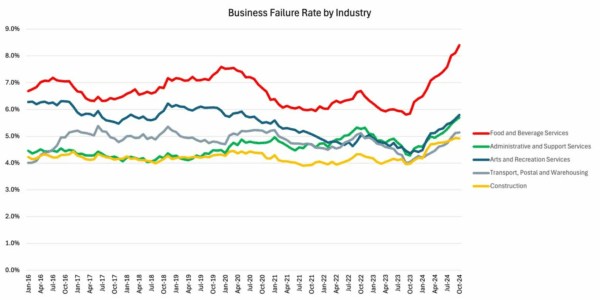Business failures have reached a peak post-pandemic, matching rates seen in October 2020, with the food and beverage sector being the most impacted.
Australian businesses are experiencing failure rates not seen since the height of the pandemic lockdowns in October 2020. While all sectors are affected, food and beverage services are hit the hardest, according to the October Business Risk Index (BRI) from CreditorWatch.
Insolvency rates on an annual basis have more than doubled over the past 18 months, surpassing pre-COVID levels by approximately 25 percent.
Court actions have also exceeded pre-COVID levels as major creditors such as banks and the ATO aim to recover debts. The number of cases rose by 13 percent from August 2023 to August 2024.
The average failure rate across all sectors currently stands at 5.04 percent of total businesses, up from 3.97 percent in October of the previous year.
The previous peak was 5.08 percent, recorded in October 2020 during the height of COVID-19. Following the initial pandemic phase, the failure rate began to decrease steadily but started rising again in October 2023.
The food and beverage sector reported the highest failure rate among all industries in the recent study, increasing to 8.5 percent on a rolling 12-month basis, up from 8.3 percent in the previous 12 months ending in September.
CreditorWatch predicts a further rise in the failure rate in the food and beverage sector to 9.1 percent over the next 12 months.
In challenging financial times, consumers tend to shift from expensive restaurants to more affordable options.
Data Broken Down
Household spending data from September by the Australian Bureau of Statistics (ABS) indicated that visits to and sales in hotels, cafes, and restaurants across all price ranges were 1.7 percent lower compared to a year ago.
Sales in the tobacco and alcohol sector showed an even weaker performance in volume terms, down by 16.6 percent year-on-year.
Administrative and support services had the second highest failure rate at 6 percent, followed by arts and recreation services (5.9 percent) and transport, postal, and warehousing (5.8 percent).
There is a possibility that the failure rate in construction (5.3 percent) is stabilizing.
Failures exceed pre-COVID levels for construction, administrative and support services, and food and beverage services. Challenges in the food service and construction sectors have been persistent.
The sectors of food and beverage, construction, arts and recreation services, and transport, postal, and warehousing tend to have a high proportion of their costs in wages and have been hit hardest by the relatively high national minimum wage increases.
Confidence Increasing
The company’s Chief Economist, Ivan Colhoun, notes that the impact of the July 1 tax cuts is not yet clear but will alleviate some pressures on consumers and businesses.
He highlights that the low unemployment rate at 4.1 percent is encouraging. Consumer confidence has improved significantly in recent months, and business confidence rose in October, with business conditions around long-term averages according to the NAB Business Survey.
CreditorWatch CEO Patrick Coghlan mentions that while inflation increases appear to have peaked, businesses are awaiting interest rate relief.
He points out, “A slowdown in the inflation rate will certainly help businesses, but this just means that price rises have slowed down, so the cost pressures remain.”
“Businesses desperately need interest rates to come down so households have some relief in cost-of-living pressures and start spending more.”
Western Sydney and South-East Queensland were identified as regions with the highest risk. Adelaide has the lowest forecasted failure rate among capital city CBDs at 5.1 percent, followed by Perth (5.2 percent), Melbourne (5.8 percent), Brisbane (5.9 percent), and Sydney (6.2 percent).
Source link





